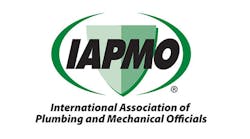Latest from Codes
Sponsored
Perhaps the plumbers and engineers who helped build the modern cities of North America back in the 19th century did their work too well? Safe, clean drinking water is today something most people in the United States simply take for granted. (There are notable exceptions; residents of Flint, Michigan, are still being instructed to drink bottled water until the last of their lead pipes have been replaced, which, according to best estimates won’t be until at least 2020.)
Sadly, waterborne pathogens are something we simply have to share the world with. Bacteria were here on this planet hundreds of millions of years before the first human. Much like us, they have prospered because of their ability to adapt and survive.
Pete DeMarco, writing this month’s Forum on Practical approaches to reducing Legionella contamination references tests that show a possible Legionella outbreak at the Springfield, IL capitol complex. More disturbing are reports from Chicago NPR affiliate WBEZ (http://interactive.wbez.org/legionnaires/) about the Illinois Veteran’s Home in Quincy, IL. Since July of 2015, legionellosis has killed 13 people and sickened 61 residents and staff.
Despite spending nearly $6.4 million on upgrades to the plumbing system at the 210-acre facility after the initial outbreak in 2015, five more people contracted Legionnaire’s disease in 2016. The most recent death occurred in fall of 2017.
While illnesses and deaths due to Legionella are rare, they have been on the rise since 2000 according to reports from the Center for Disease Control (https://www.cdc.gov/legionella/surv-reporting.html ). Part of the reason is an aging population; the elderly are more likely to have compromised immune systems. Another factor may be aging plumbing systems, which are more susceptible to contamination by bacteria.
But a disturbing possibility may lie, paradoxically, with modern plumbing advances. As DeMarco points out, today’s systems with their lower flow rates have longer transit times, increasing the potential for pathogen growth. Rainwater catchment and graywater systems – while fantastic for water conservation -- lead to the increased likelihood of cross-contamination.
The hope is that the same ingenuity that creates advances in plumbing systems can be harnessed to address those unintended consequences. A good example of this is the Emerging Water Technologies Symposium, scheduled for May 15-16 in Ontario, CA.
One of the key presentations scheduled for the biennial event is Steven Buchberger and Daniel Cole discussing the first statistically based update to Hunter’s Curve since the 1940’s. The new approach to pipe sizing will hopefully improve water and energy efficiency while mitigating opportunistic pathogens.
Also speaking directly to the issue is Prof. Dr. Thomas Kistemann from the Institute for Hygiene & Public Health, Bonn University in Germany with a presentation on the “Unintended Consequences of Water Efficiency,”
Almost every plumber knows the phrase, “The Plumber Protects the Health of the Nation,” but do you know where the slogan (and the famous poster) had its start? It was part of an effort to promote sanitary plumbing in the aftermath of an outbreak of amebic dysentery in 1933 that caused the deaths of 98 people. We owe it to our profession and to the communities we serve to stay up on the latest advances, and one step ahead in the fight against waterborne disease.
Steve Spaulding | Editor-inChief - CONTRACTOR
Steve Spaulding is Editor-in-Chief for CONTRACTOR Magazine. He has been with the magazine since 1996, and has contributed to Radiant Living, NATE Magazine, and other Endeavor Media properties.


